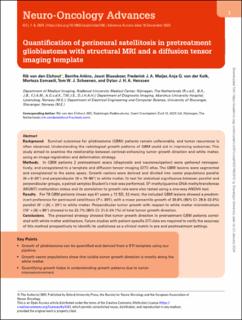| dc.contributor.author | van den Elshout, Rik | |
| dc.contributor.author | Ariëns, Benthe | |
| dc.contributor.author | Blaauboer, Joost | |
| dc.contributor.author | Meijer, Frederick J A | |
| dc.contributor.author | van der Kolk, Anja G | |
| dc.contributor.author | Esmaeili, Morteza | |
| dc.contributor.author | Scheenen, Tom W J | |
| dc.contributor.author | Henssen, Dylan J H A | |
| dc.date.accessioned | 2024-01-24T11:31:34Z | |
| dc.date.available | 2024-01-24T11:31:34Z | |
| dc.date.created | 2024-01-22T13:28:30Z | |
| dc.date.issued | 2023 | |
| dc.identifier.citation | van den Elshout, R., Ariëns, B., Blaauboer, J., Meijer, F. J., van der Kolk, A. G., Esmaeili, M., ... & Henssen, D. J. (2024). Quantification of perineural satellitosis in pretreatment glioblastoma with structural MRI and a diffusion tensor imaging template. Neuro-Oncology Advances, 6(1), vdad168. | en_US |
| dc.identifier.issn | 2632-2498 | |
| dc.identifier.uri | https://hdl.handle.net/11250/3113549 | |
| dc.description.abstract | Background
Survival outcomes for glioblastoma (GBM) patients remain unfavorable, and tumor recurrence is often observed. Understanding the radiological growth patterns of GBM could aid in improving outcomes. This study aimed to examine the relationship between contrast-enhancing tumor growth direction and white matter, using an image registration and deformation strategy.
Methods
In GBM patients 2 pretreatment scans (diagnostic and neuronavigation) were gathered retrospectively, and coregistered to a template and diffusion tensor imaging (DTI) atlas. The GBM lesions were segmented and coregistered to the same space. Growth vectors were derived and divided into vector populations parallel (Φ = 0–20°) and perpendicular (Φ = 70–90°) to white matter. To test for statistical significance between parallel and perpendicular groups, a paired samples Student’s t-test was performed. O6-methylguanine-DNA methyltransferase (MGMT) methylation status and its correlation to growth rate were also tested using a one-way ANOVA test.
Results
For 78 GBM patients (mean age 61 years ± 13 SD, 32 men), the included GBM lesions showed a predominant preference for perineural satellitosis (P < .001), with a mean percentile growth of 30.8% (95% CI: 29.6–32.0%) parallel (0° < |Φ| < 20°) to white matter. Perpendicular tumor growth with respect to white matter microstructure (70° < |Φ| < 90°) showed to be 22.7% (95% CI: 21.3–24.1%) of total tumor growth direction.
Conclusions
The presented strategy showed that tumor growth direction in pretreatment GBM patients correlated with white matter architecture. Future studies with patient-specific DTI data are required to verify the accuracy of this method prospectively to identify its usefulness as a clinical metric in pre and posttreatment settings. | en_US |
| dc.language.iso | eng | en_US |
| dc.publisher | Oxford University Press | en_US |
| dc.rights | Navngivelse 4.0 Internasjonal | * |
| dc.rights.uri | http://creativecommons.org/licenses/by/4.0/deed.no | * |
| dc.title | Quantification of perineural satellitosis in pretreatment glioblastoma with structural MRI and a diffusion tensor imaging template | en_US |
| dc.type | Peer reviewed | en_US |
| dc.type | Journal article | en_US |
| dc.description.version | publishedVersion | en_US |
| dc.rights.holder | © The Author(s) 2023 | en_US |
| dc.subject.nsi | VDP::Medisinske Fag: 700 | en_US |
| dc.source.volume | 6 | en_US |
| dc.source.journal | Neuro-Oncology Advances (NOA) | en_US |
| dc.source.issue | 1 | en_US |
| dc.identifier.doi | 10.1093/noajnl/vdad168 | |
| dc.identifier.cristin | 2231945 | |
| cristin.ispublished | true | |
| cristin.fulltext | original | |
| cristin.qualitycode | 1 | |

